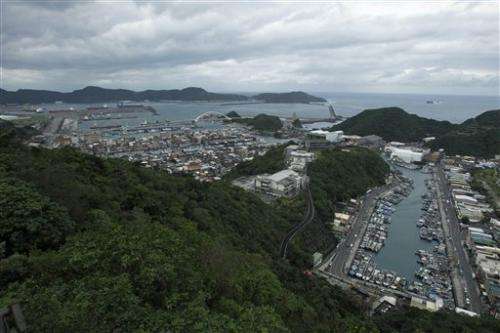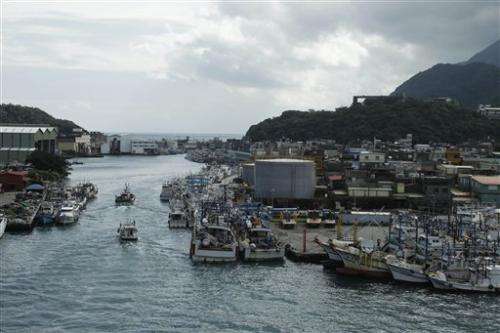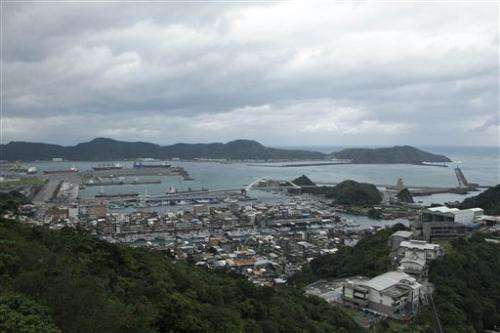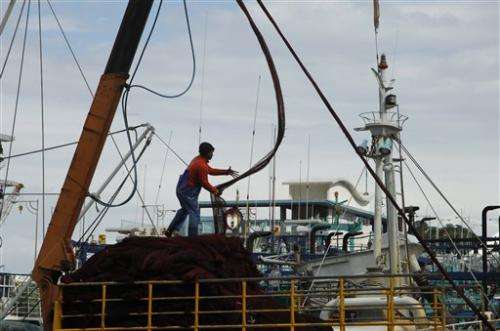Disputed Asian islands once had strategic role

(AP)—Perched on a narrow promontory jutting off Taiwan's heavily industrialized northeastern coast, the Suao naval base is only 220 kilometers (140 miles) from a rocky group of islets at the center of a bitter territorial dispute between Japan and China.
Along with Taiwan, the islets—called the Diaoyu islands in China and the Senkakus in Japan—form part of what military strategists call the "first island chain." The string of islands and atolls extends along China's eastern periphery from South Korea to the southern Philippines, taking in a number of other disputed territories—notably the Paracel and Spratly islands in the South China Sea.
While most explanations for the territorial disputes focus on nationalistic pride and access to rich fishing grounds or potentially large reserves of oil and gas, the first island chain once figured prominently in strategic calculations—and some say still has strategic relevance today.
Military interest in the chain dates from at least the 1920s, when American planners concluded it could play a key role in helping the U.S. defend against rising Japanese militarism. After the communist victory in the Chinese civil war in 1949, Washington came to regard the chain as an important vehicle for containing Chinese military expansion, with special emphasis on Taiwan's role in it. U.S. Gen. Douglas MacArthur called the island "an unsinkable aircraft carrier," whose position 160 kilometers (100 miles) off China gave it the ability to project power all along the mainland's eastern coast.
MacArthur's doctrine helped focus Beijing's attention on the chain's strategic value. Admiral Liu Huaqing, head of the Chinese navy from 1982 to 1986, saw control of the waters within its boundaries as the first step in a three-stage strategy to transform the navy into a formidable platform for projecting Chinese power. The next stage, he wrote, involved controlling a second island chain linking the Ogasawara Islands—including Iwo Jima—with Guam and Indonesia, while the third stage focused on ending American dominance throughout the Pacific and Indian oceans, largely by deploying aircraft carriers in the region.

Contemporary analysts are divided on whether the chain has lost its strategic relevance, notwithstanding the rapid expansion of the Chinese navy. Skeptics say that China's acquisition of advanced, longer-range missiles means it can defend itself from its own shores, though the island chain still creates vulnerable chokepoints for Chinese vessels heading to sea.
"In my view, technology is diminishing the relevance of geographic strategy," former American military attache in Beijing Mark Stokes said in an email. "For example, the ability to strike moving targets at sea from southeast China at extended ranges reduces the need for cruise missile platforms closer to sea lines."
This view was echoed by Shanghai University of Law and Political Science military affairs expert Ni Lexiong.
"In the era of the fast development of military technology such as missiles, air strikes and nuclear weapons, the military role of the first island chain is getting less important," Ni said. "For instance, if China acquires advanced military technology, it will be useless for the U.S. ... to make military deployment along the first island chain because it's easy to get attacked."

Countering Stokes and Ni are the geographic-centric arguments of chain advocates such as geopolitical analyst and author Robert Kaplan—his latest book is titled "The Revenge of Geography"—and East Asia military specialist Dan Blumenthal of Washington's American Enterprise Institute, who believes the chain is important in safeguarding U.S. strategic assets all the way to the sprawling American military facility in Guam.
"The chain matters," Blumenthal wrote in an email, emphasizing the U.S. could thwart ocean-bound Chinese submarines at the chokepoints. "It is very hard to defend the Pacific if you lose the ability to slam the gate shut."
The official American view appears to be to ignore the chain, lest an increasingly powerful China react aggressively. The Obama administration believes it makes far better sense to approach Beijing not so much as a rival but as a potential partner for dealing with a welter of crucial issues—nuclear proliferation, for example, as well as climate change and global economic security.
"We are in the same boat, and we will either row in the same direction or we will, unfortunately, cause turmoil and whirlpools that will impact not just our two countries, but many people far beyond either of our borders," Secretary of State Hillary Rodham Clinton declared in a 2011 speech dedicated to U.S.-China relations.
Since then, the regional geopolitical climate has grown much tenser, fed by a series of confrontations between Japan and China over the disputed islets and escalating friction between Beijing and a number of Southeast Asian countries over expanding Chinese territorial claims in the South China Sea.

Under its "Pacific Pivot" policy, Washington has expanded military exercises in the region and placed important military resources in strategic Asian locations, but it has made no mention at all of the chain and avoided taking sides in the territorial disputes.
Treating the chain as a relic seems a dubious proposition here in Suao, which looks out onto a broad expanse of open water that Chinese naval vessels often cross en route to the Pacific. On a recent weekday morning, three Taiwanese corvettes lolled placidly in its waters, just to the west of a breakwater.
But the U.S. ended its direct military relationship with Taiwan in the run-up to the transfer of its recognition from Taipei to Beijing in 1979, effectively removing Taiwan from the first island chain, and few analysts expect it will be reintegrated anytime soon.
"I think we have come to a point where maintaining cordial ties with China trumps lesser concerns for many in official Washington," said James Holmes of the U.S. Naval War college in Newport, Rhode Island, writing in an email. "No U.S. government agency sees a pressing stake in Taiwan anymore."
Copyright 2012 The Associated Press. All rights reserved. This material may not be published, broadcast, rewritten or redistributed.




















